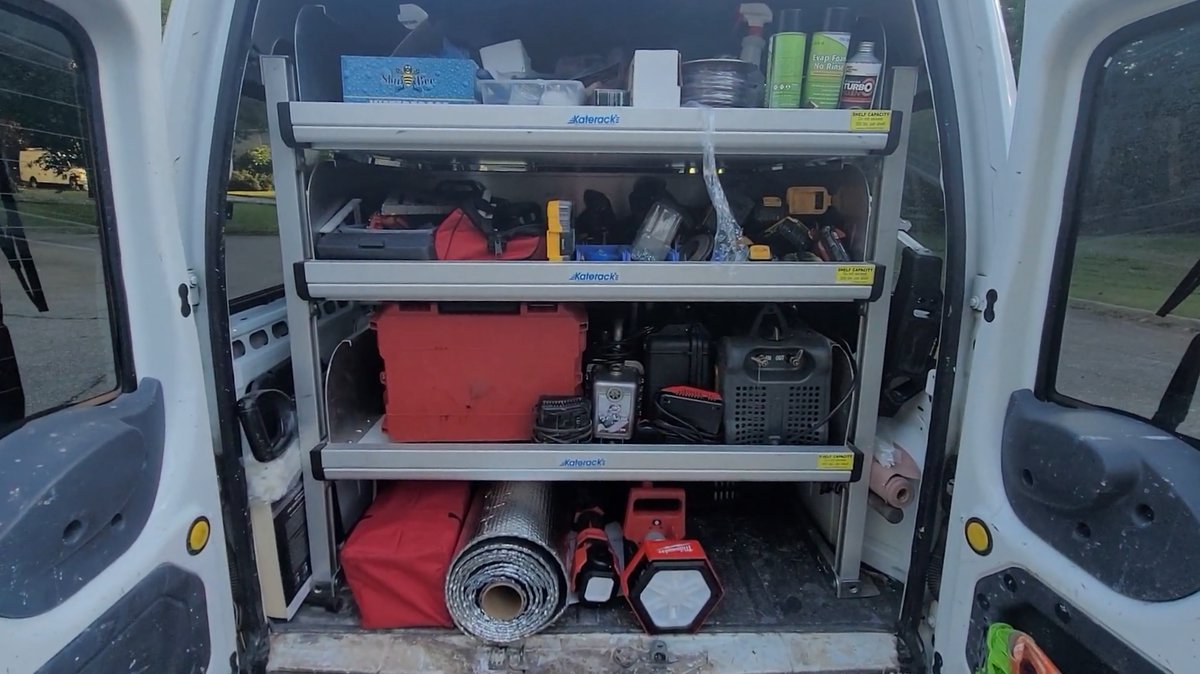Lora's HVAC Install and Service Transit Connect
RIG DETAILS
| USED FOR | HVAC |
| TYPICAL JOBS | service, installation, new construction |
| MODEL | 2013 Ford Connect |
| BODY | Compact Cargo Van |
| DRIVETRAIN | Gas |
| VEHICLE'S FUEL MILEAGE | 25-26 mpg |
ORGANIZATION
Lora's Ford Transit Connect is used for HVAC installation and service in South Carolina. It is a small van with a lot packed into it.
Why a Connect?
His previous van was a fuel-guzzling Chevy KUV 3500 that was too big. A downsize like this will make you think differently about how you work and what kind of systems you can develop to be efficient! He now gets 24-25 MPG, even with a ladder rack.
Lora has a great system that brings the inside of the van outside and makes it efficient to find tools and inventory without climbing into the van. Fully packed, he says he is close to the 5000 gross weight rating for the Connect.
See More:
Packed HVAC Connect Organization
Many HVAC companies want to try Transit Connects because they are more fuel efficient than larger vans. This can be challenging because Transits are so small and there is little room for inventory. Supply house runs are costly for companies with larger fleets, so some strategy is required to figure out how much and what inventory to carry.
It's worth pointing out that small vans are more normal in other countries, even for plumbing, HVAC, and electrical work.
The keys to Lora's setup are having dual side cargo doors and a pull-out shelf system. Everything is within reach without needing to climb into the van.
Empty cargo space can be filled and contents are accessed from outside. This is unlike a typical HVAC van that's designed with an open cargo area where the tech accesses everything from inside.
Note that this setup lacks a bulkhead to separate the cargo area from the seat area. This is legally required in many areas, and we like to see it to keep the driver and passenger safe.
Passenger Cargo Door
On the passenger side, twin tank racks are bolted down behind the seats and hold several tanks of refrigerant and nitrogen.
Note that best practice is to store your acetylene tanks with the valve up. Using an acetylene tank directly after it lays on its side can make it explosive! Let tanks laid on their side stand valve-up for a few hours before using them.
Lora has his in-use oxyacetylene setup with both tanks standing up behind the passenger seat.
His gauge set hangs out of the way on the tank rack, and a hand truck makes it easy to move equipment to a job site.

Driver Cargo Door
Behind the driver seat Lora keeps copper tubing and his Veto Pro Pac tool backpack. There is a surprising amount of space left here that could be used for more tools and service supplies.
Pull Out Shelves at the Back
A great strategy for small vans and capped pickup trucks is to bring the inside of the van outside. This Connect uses a Dejana Katerack 3-drawered shelf system that pulls out of the van's rear cargo doors.
Drawer height is infinitely adjustable so that a tech can find the correct height for tools, or reconfigure at a later time.
Lora's shelves are tightly packed with tools and a small amount of inventory. It's easy to see how quick tool access is with the drawer system. Bulky, heavy items go on the bottom. The middle shelf is for his DeWalt power tools. The top shelf is mostly a mix of inventory, cleaning, and leftover bits and pieces.
Room for Ladders
A short step ladder and a multipurpose ladder reside on the ladder rack on the roof. Using a ladder rack can have a lot of cons, including the negative impact on your fuel efficiency. However, the Connect's fuel efficiency is enough so that it's still well worth it, even with a fuel-sucking rack and ladder combo.
If he could do away with the ladder rack, he'd likely see a 1-2 MPG increase in economy.
A small, thin step ladder slots in the space between the van's racking and the wall.
But how do installations work?
Obviously, this van will not fit a condensor or a boiler unit. Lora says that he mostly has units delivered, and this is a great option that works for many businesses that want to reduce fuel and vehicle costs by using a smaller van.
For some installations, or when Lora needs to remove equipment, he connects a 5'x8' trailer to the Transit's hitch for hauling. He says that the van works well for towing.
Conclusion
Lora's Transit Connect shows how an HVAC company could do service and installs out of one compact van. Space for inventory is limited, but the no-climb access afforded by the dual side cargo doors and the rear pull-out shelf system keeps his tool and inventory load accessible.
Having HVAC units delivered or occasionally pulling units on a trailer behind the van allows him to drive a small van with significantly more fuel efficiency than a larger van.
Get work trucks and tips in your mailbox.
Your time is precious. We write about organization, tools, and techniques that make tradespeople work faster and more efficiently. Subscribe to get our articles and tips in your inbox.
We will not spam you.



